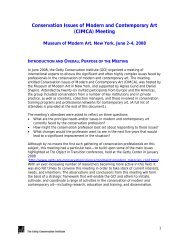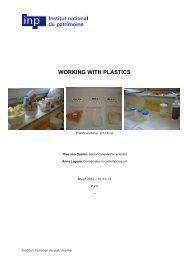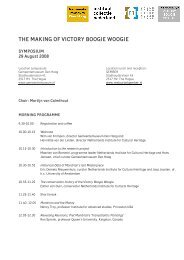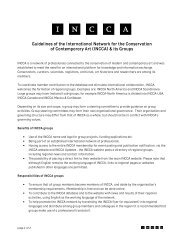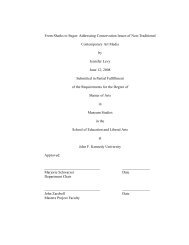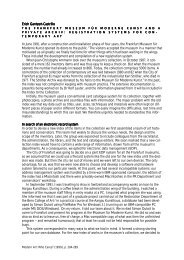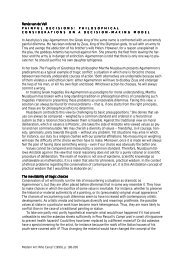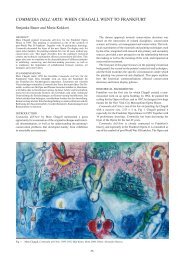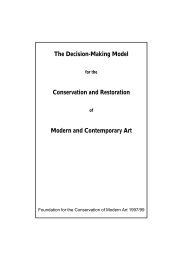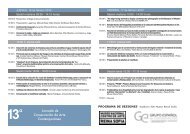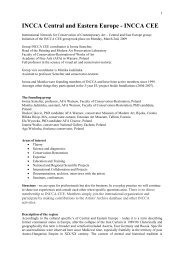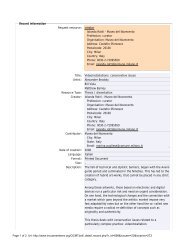Installations and problems of preservation.pdf - incca
Installations and problems of preservation.pdf - incca
Installations and problems of preservation.pdf - incca
Create successful ePaper yourself
Turn your PDF publications into a flip-book with our unique Google optimized e-Paper software.
what the window framed as integral to the work. Turrell works with the space, creating an environment<br />
which speaks pr<strong>of</strong>oundly to the viewer or visitor. 7<br />
The problem here is not that <strong>of</strong> preserving an object. This installation, set up in the Panza Villa<br />
in Varese <strong>and</strong> now belonging to the Guggenheim Museum, is a site-specific work <strong>and</strong> will not<br />
inhabit any other space. Recently it was deinstalled in order to complete renovations to the villa.<br />
The documents were carefully review-ed in order to ensure that it will be reinstalled correctly. When<br />
the artist created the work, specific instructions were given as to how the existing space should be<br />
modified to enable the creation. A certificate <strong>of</strong> ownership <strong>and</strong> Document <strong>of</strong> Realisation are an<br />
essential component <strong>of</strong> the work.<br />
Although the environment/installation was primarily constructed with new walls, they were most<br />
certainly a response to the villa – for example, to the lunette window. Other essential components<br />
<strong>of</strong> the piece are the daylight, especially the direction <strong>of</strong> the light, <strong>and</strong> what can be viewed from the<br />
window. All <strong>of</strong> these components would be impossible to recreate in another building or l<strong>and</strong>scape.<br />
If the building were destroyed, the work would live on only as documentation.<br />
The artist is very clear in the documentation that certain technical parameters must be followed.<br />
He specifies with utmost precision such details as lighting, projectors, wall finish, the height <strong>of</strong> the<br />
floor under the entrance etcetera. He also states that he should be contacted <strong>and</strong> sign <strong>of</strong>f on any recreation<br />
<strong>of</strong> the space.<br />
As far as I know, the re-creation <strong>of</strong> his works after his death has not been addressed – so possibly<br />
the work will die with him. This points to the necessity <strong>of</strong> well structured interviews with the<br />
artist, to define the works in the museum’s collection <strong>and</strong> hopefully to document his general philosophy<br />
for the continuation <strong>of</strong> his oeuvre (Guggenheim Museum curators are planning to confront<br />
these issues with the artist, but at present they feel that no Turrell work should ever be recreated<br />
without his involvement). The outcome <strong>of</strong> the interviews should contribute to the overall<br />
comprehension <strong>of</strong> the artist’s work. Results <strong>of</strong> such an interview should be accessible to others<br />
who encounter similar works <strong>and</strong> are trying to interpret his work <strong>and</strong> future documentation. Some<br />
important questions for works by Turrell would be:<br />
— How much latitude (if any) is allowed for changes in materials, dimensions, technology?<br />
— Will someone be designated as executor who can sign <strong>of</strong>f on re-creations after his death?<br />
— Is there someone who the artist feels has a pr<strong>of</strong>ound <strong>and</strong> accurate underst<strong>and</strong>ing <strong>of</strong> his work?<br />
Città Irreale, Millenovecentoottantanove was conceived for a show at the Guggenheim Museum,<br />
New York, in 1989 – created in situ as an immediate, spontaneous response to the space. At the<br />
artist’s request a number <strong>of</strong> different materials were collected. The artist then worked with these<br />
elements to gradually create the igloos. He began to cut the glass sheets with gr<strong>and</strong> gestures but<br />
this method in fact turned out to be impractical, so the art h<strong>and</strong>lers measured them <strong>and</strong> carefully<br />
fitted the broken glass onto the clamps.<br />
The work begins with a very simple structure, the igloo, which Merz transforms during the creative<br />
process. It refers to energy, shelter, electrical poles <strong>and</strong> oppositions. Both its meaning <strong>and</strong><br />
physical structure are complex <strong>and</strong> layered. Opposing forces <strong>and</strong> materials combine to form a precarious<br />
architecture, with stable <strong>and</strong> unstable materials juxtaposed <strong>and</strong> supporting each other. 8<br />
An interesting issue pertaining to the work is the existence – or non-existence – <strong>of</strong> the neon element.<br />
Originally, this was a separate work. Two versions <strong>of</strong> the neon piece were in the exhibition,<br />
one owned by the Stedelijk Museum Amsterdam <strong>and</strong> one owned by a private lender. The neon work<br />
from the private lender was used on top <strong>of</strong> the large igloo at the last minute, being an unpredictable<br />
aspect <strong>of</strong> the creative process. It was an integral part <strong>of</strong> the installation – which was titled after<br />
this element – at the Guggenheim.<br />
The work was acquired by the Guggenheim at the time, but not documented clearly. There was<br />
no indication whether this neon element was supposed to be copied or borrowed from the lender<br />
every time the work was reinstalled. An attempt was made by the art h<strong>and</strong>ling/technical staff to recreate<br />
the element, but this was neither successful nor authorised: the artist has suggested that we<br />
show the piece without the neon element. Until further decisions are made, this is how the work<br />
will be installed.<br />
Modern Art: Who Cares? (1999), p. 272-281



